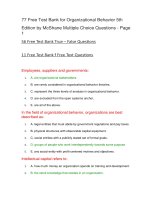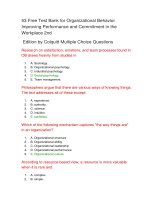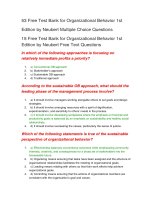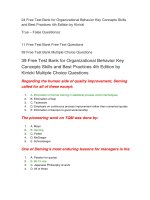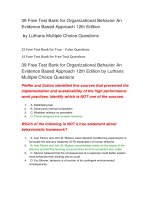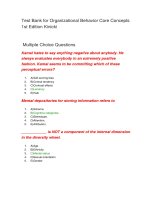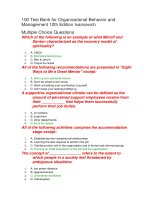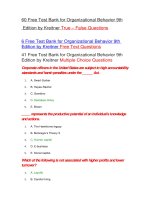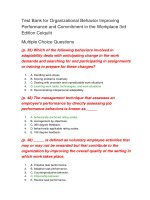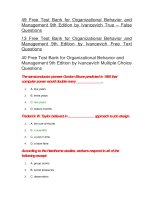100 test bank for organizational behavior and management 10th edition ivancevich
Bạn đang xem bản rút gọn của tài liệu. Xem và tải ngay bản đầy đủ của tài liệu tại đây (113.38 KB, 18 trang )
100 Test Bank for Organizational Behavior and
Management 10th Edition Ivancevich
Multiple Choice Questions
Which of the following is an example of what Mitroff and
Denton characterized as the recovery model of
spirituality?
1.
2.
3.
4.
A. YMCA
B. Alcoholics Anonymous
C. Ben & Jerry’s
D. Cirque Du Soleil
All of the following recommendations are presented in "Eight
Ways to Be a Great Mentor" except:
1.
2.
3.
4.
A. Give up your personal mentor
B. Don't be afraid to be honest
C. Work at building trust and feeling it yourself
D. Don't keep your feelings bottled up
A supportive organizational climate can be defined as the
amount of perceived support employees receive from
their ___________ that helps them successfully
perform their job duties.
1.
2.
3.
4.
A. co-workers
B. supervisor
C. other departments
D. All of the above
All of the following activities comprise the accommodation
stage except:
1.
2.
3.
4.
A. Establishing new interpersonal relationships
B. Learning the task required to perform the job
C. Clarifying one's role in the organization and in formal and informal groups
D. Forming an initial impression of the job and the organization
The concept of _______________ refers to the extent to
which people in a society feel threatened by
ambiguous situations.
1.
2.
3.
4.
A. low power distance
B. aggressiveness
C. uncertainty avoidance
D. individualism
Socialization processes are the activities by which an
individual comes to appreciate the _______________
essential for assuming an organizational role, and for
participating as an organization member.
1.
2.
3.
4.
A. values
B. abilities
C. expected behaviors
D. All of the choices are correct.
Employees are more likely to adjust to a new job and be
accepted socially if they use a _______________
approach to learning about how things work, who
makes the decisions, and what the organization
values.
1.
2.
3.
4.
A. proactive
B. laid-back
C. scientific
D. sequential
____________ is the sum total of the beliefs, rituals, rules,
customs, artifacts, and institutions that characterize
the population of the nation.
1.
2.
3.
4.
A. Culture
B. A national culture
C. A national perspective
D. A guiding perspective
Spirituality in the work place _________.
1.
2.
3.
4.
A. is always positive.
B. is always a negative
C. may have a negative side
D. is appropriate only in religious organization
The sink or swim approach to socialization ___________.
1.
2.
3.
4.
A. is preferred to others
B. never works
C. may work
D. never involves mentoring
__________ are the conscious, affective desires or wants of
people that guide behavior
1.
2.
A. Cultures
B. Values
3.
4.
C. Needs
D. Wants
Which of the following statements about spirituality is false?
1.
2.
3.
4.
A. Spirituality is a personal and private path.
B. Spirituality contains elements of many religions.
C. Spirituality grows from self-inquiry.
D. None of the statements are false.
Which of the following statements about spirituality is true?
1.
2.
3.
4.
A. Spirituality is a personal and private path
B. Spirituality contains elements of many religions
C. Spirituality grows from self-inquiry
D. All of the choices are correct.
Which of the following is an example of what Mitroff and
Denton characterized as an evolutionary model of
spirituality?
1.
2.
3.
4.
A. YMCA
B. Alcoholics Anonymous
C. Ben & Jerry’s
D. Cirque Du Soleil
When are we most receptive to information about a job or an
organization?
1.
2.
3.
4.
A. When faced with the need to make a decision
B. When offered monetary incentives to do so
C. When we hear it for the first time
D. After we have made a mistake
All of the following are phases in the mentoring process
except:
1.
2.
3.
4.
A. Separation
B. Cultivation
C. Realism
D. Redefinition
Attempting to change a culture generally requires all of the
following except:
1.
2.
3.
4.
A. Difficult techniques
B. A new company leader
C. Rare skills
D. Considerable time
Hofstede's five value dimensions are power distance,
individualism, uncertainty avoidance, masculinity, and
_______________.
1.
2.
3.
4.
A. accommodation
B. femininity
C. integrity
D. long-term orientation
Which of the following does Johnson & Johnson consider
their first responsibility?
1.
2.
3.
4.
A. Maintaining reasonable prices
B. Their employees
C. Treating everyone as an individual
D. The people who use their products and services
Within the Globe Project, ________________ refers to the
degree to which individuals in an organization are
rewarded for being friendly, altruistic, fair, caring, and
kind to others.
1.
2.
3.
4.
A. egalitarianism
B. gender egalitarianism
C. humane orientation
D. altruistic orientation
Which of the following is the least likely to be a turning point
during a mentoring relationship?
1.
2.
3.
4.
A. The senior manager becomes less available
B. A job rotation or promotion limits continued interaction
C. Peer status is achieved
D. A sudden increase in opportunities for interaction around work tasks
_______________ is the process by which organizations
bring new employees into the culture.
1.
2.
3.
4.
A. Alteration
B. Maturation
C. Socialization
D. Normalization
All of the following practices are found during the
accommodation socialization stage except:
1.
2.
3.
A. Professional counseling
B. Social skills training
C. Demanding but fair supervisors
4.
D. Supportive and accurate feedback
Organizational socialization processes _______ from
organization to organization.
1.
2.
3.
4.
A. by law must not vary
B. may vary in form but not content
C. vary in form and content
D. must by law vary by employee
Performance orientation is the degree to which:
1.
A. Members of organizations are aggressive and confrontational in social
relationships.
2. B. Individuals in a society are rewarded for performance improvement and
excellence.
3. C. Members of a society or organization use rules, regulations, and social norms
to avoid uncertainty or unpredictable future events.
4. D. Individuals express loyalty, pride, and cohesiveness in their organizations and
families.
The "separation" phase of the mentor relationship occurs
after the _____________phase.
1.
2.
3.
4.
A. cultivation
B. redefinition
C. friendship
D. conflict
Socialization is most important when an individual
__________________.
1.
2.
3.
4.
A. first takes a job
B. takes a different job in the same organization
C. has failed to meet performance expectations
D. Both A and B are correct.
Which of the following is an example of what Mitroff and
Denton characterized as the socially responsible
model of spirituality?
1.
2.
3.
4.
A. YMCA
B. Alcoholics Anonymous
C. Ben & Jerry’s
D. Cirque Du Soleil
Research suggests that, when ethics codes are developed
and enforced within an organization, they have a
positive impact on _______________.
1.
A. job satisfaction
2.
3.
4.
B. esprit de corps
C. organizational commitment
D. All of the choices are correct.
_____ can be defined as the amount of perceived support
employees receive from their co-workers, supervisor,
and other departments that helps them successfully
perform their job duties.
1.
2.
3.
4.
A. BOC
B. HFC
C. HGC
D. SOC
Conflict between an individual's work group and other work
groups within the organization usually surface during
the _______________ socialization stage.
1.
2.
3.
4.
A. anticipatory
B. accommodation
C. role management
D. All of the choices are correct.
Considerable conflict between job and family roles reflects a
high level of the societal value of _______________.
1.
2.
3.
4.
A. power distance
B. masculinity
C. uncertainty avoidance
D. individualism
The Global Leadership and Organizational Behavior
Effectiveness (GLOBE) project was conceived by
____________.
1.
2.
3.
4.
A. Geert Hofstede
B. E.H. Schein
C. Robert House
D. Ronald King
Herb Kelleher, one of the founders of Southwest Airlines,
helped create a culture of commitment by:
1.
2.
3.
4.
A. Pitching in to help employees as he traveled around doing business.
B. Rewarding the most productive and upbeat employees.
C. Conducting regular and intense team-building sessions.
D. All of the answers are correct.
Which of the following channels is likely to help pass values
from one generation to the next?
1.
2.
3.
4.
A. Religion
B. Communities
C. The education system
D. All of the choices are correct.
Research by Mitroff and Denton found that there was
___________agreement about the meaning of
spirituality.
1.
2.
3.
4.
A. weak
B. diverse
C. near-unanimous
D. unanimous
According to the text, which of the following organizations is
an example of using a values-based model of
spirituality?
1.
2.
3.
4.
A. Alcoholics Anonymous
B. Kingston Technology
C. Ben & Jerry's
D. YMCA
During the _______________ stage, a broader set of issues
and problems arises, which results in conflict,
including conflict between work groups.
1.
2.
3.
4.
A. anticipatory socialization
B. accommodation
C. role management
D. All of the choices are correct.
The values, norms, customs, and rituals of cultures are
influenced by _______________.
1.
2.
3.
4.
A. politics
B. religion
C. language
D. All of the choices are correct.
in countries with lower levels of uncertainty avoidance,
_______________.
1.
2.
3.
A. organizational activities are less formal
B. more risk taking occurs
C. there is high job mobility
4.
D. All of the choices are correct.
____________ has been defined as “the desire to find
ultimate meaning and purpose in one’s life and to live
an integrated life."
1.
2.
3.
4.
A. Religiousality
B. Spirituality
C. Transformationality
D. None of the above.
Within the Globe Project, ________________ refers to the
extent to which an organization avoids gender
discrimination and role inequities.
1.
2.
3.
4.
A. masculinity
B. gender egalitarianism
C. gender orientation
D. justice
The culture at Walt Disney is manifested through all of the
following except:
1.
2.
3.
4.
A. Shared sayings.
B. Similar demographic characteristics.
C. Shared things.
D. Shared behavior.
A (n) _______________ is a material object manufactured by
people to facilitate culturally expressive activities.
1.
2.
3.
4.
A. symbol
B. sage
C. myth
D. artifact
A study of spirituality reported that organizational spirituality
was positively correlated to:
1.
2.
3.
4.
A. Employee job involvement
B. Organizational identification
C. Work rewards satisfaction
D. All of the choices are correct.
A survey by Mitroff and Denton found all of the following to
be true except:
1.
2.
3.
A. Employees who are more spiritually involved achieve better results.
B. Most employees feel free to act on their spirituality in the workplace.
C. People differentiate strongly between religion and spirituality.
4.
D. Most people define spirituality as "the desire to find ultimate meaning and
purpose in one's life and to live an integrated life."
In work organizations, a mentor can provide ___________to a
younger, less-experienced protégé.
1.
2.
3.
4.
A. coaching
B. friendship
C. role modeling
D. All of the above.
The core values of Southwest Airlines consist of all of the
following elements except:
1.
2.
3.
4.
A. A warrior spirit
B. A servant's heart
C. A fun-loving attitude
D. An unwavering commitment
The socialization that occurs before someone enters an
organization, or takes a different job within an
organization, is the _______________ stage of
socialization.
1.
2.
3.
4.
A. accommodation
B. anticipatory
C. role management
D. assessment
_______________ is the degree to which members of a
society or organization use rules, regulations, and
social norms to avoid uncertainty or unpredictable
future events.
1.
2.
3.
4.
A. Power distance
B. Societal collectivism
C. Future orientation
D. Uncertainty avoidance
True - False Questions
Organizational culture creates a pattern of beliefs, values,
and expectations in employees.
1.
2.
True
False
Weeding out cultural misfits should be done only after
weighing the costs and benefits of losing talented
performers.
1.
2.
True
False
The effect of values on workplace productivity and
effectiveness is easily measured.
1.
2.
True
False
In countries in which people display low power distance,
employees acknowledge the boss's authority and
typically follow the chain of command.
1.
2.
True
False
Research indicates that most managers have never had a
mentor.
1.
2.
True
False
Rituals, history, humor, and employee rewards have resulted
in Nordstrom's being recognized as a leader in how to
treat customers.
1.
2.
True
False
Over the past decade research in to spirituality has grown
out of favor.
1.
2.
True
False
Organizations are able to operate most efficiently when
shared values exist among the employees.
1.
2.
True
False
In countries with high masculinity, one finds less conflict
and stress when it comes to balancing home and work
life.
1.
True
2.
False
Researchers who have studied the impact of culture on
employees indicate that it provides and encourages a
form of stability.
1.
2.
True
False
The extent to which subordinates accept unequal power is
the same across countries.
1.
2.
True
False
Workplace spirituality is the same as workplace religion.
1.
2.
True
False
Behavioral compliance is a general indicator of cultural
commitment.
1.
2.
True
False
Values are a society's ideas about what is right or wrong,
such as the belief that hurting someone is immoral.
1.
2.
True
False
An organization's culture can't be seen, sensed, or felt.
1.
2.
True
False
Someone who is promoting and prodding others to show or
be more spiritual may also be disrupting the work
performance of colleagues.
1.
2.
True
False
Generally, individuals having unmanaged stress works to the
advantage of the organization.
1.
2.
True
False
Organizations can achieve effectiveness only when
employees share values.
1.
2.
True
False
People are attracted to mentors who look, act, and
communicate like themselves.
1.
2.
True
False
As the needs of an organization change, its employees must
adapt to those new needs. That is, they must continue
to be socialized.
1.
2.
True
False
Individuals who experience realism and congruence during
the anticipatory stage of socialization have a less
stressful accommodation stage
1.
2.
True
False
In the role management stage of socialization, individuals
become organizational members and see the job and
organization for what they are.
1.
2.
True
False
If quality customer service is important in the culture, then
individuals will be expected to adopt this behavior.
1.
2.
True
False
Mentoring relationships generally last from six months to
more than five years.
1.
2.
True
False
Southwest Airlines has established a strong culture in part
due to its hiring practices. Their approach is "hire for
the skill and train the attitude."
1.
True
2.
False
A person's feelings and perceptions are usually kept at the
conscious level.
1.
2.
True
False
Free Text Questions
Hey guys! Don’t hesitate when your opportunity is coming, here test bank is new
study tool to help you practice easily and improve effectively your knowledge. If
you are looking for free test bank organizational behavior to develop your critical
and skills for passing for the next examination that is the best of choice to ensure
that you will take fully understanding by practicing 24 Free Test Bank for
Organizational Behavior and Management 10th Edition Invacevich free text
questions and lots other practice test questions of this key topic. Let’s start this
practical test below to become professional for your coming examination right
now!
Exam Finished
Thank you for your time.
24 Free Test Bank for Organizational Behavior and
Management 10th Edition Ivancevich Free Text
Questions
What is the best way to learn how to be a mentor?
Answer Given
The best way to learn how to be a mentor is to be mentored yourself.
The results of the Mitroff and Denton research led them to
identify a number of distinct models that describe how
workplace spirituality can be practiced. Describe these
models.
Answer Given
The results of the Mitroff and Denton research led them to identify a number of
distinct models that describe how workplace spirituality can be practiced: recovery
(e.g., Alcoholics Anonymous), evolutionary (evolved from religious to more
ecumenical, (e.g., YMCA), socially responsible (e.g., Ben & Jerry’s), values-based
(e.g., Kingston Technology), and religion-based (e.g., Mormon-owned Ag
Reserves, Inc.). These five models representing different kinds of spirituality in
organizations suggest that spirituality can be productive, encouraging trust,
work/life balance, empathy and compassion about others, the valuing of human
assets, the full development and self-actualization of people, and ethical behavior.
What were three of Mitroff and Denton’s findings?
Answer Given
They found that: Employees who are more spiritually involved achieve better
results; There was near-unanimous agreement about the meaning of spirituality:
“the desire to find ultimate meaning and purpose in one’s life and to live an
integrated life.” Few respondents feel they can act on their spirituality in the
workplace; Employees do not want to fragment their lives. They want to be
acknowledged as whole persons in the workplace; People differentiate strongly
between religion and spirituality.
What major activities comprise the accommodation stage of
socialization?
Answer Given
Four major activities comprise the accommodation stage: All individuals, to a
degree, must engage in (1) establishing new interpersonal relationships with both
co-workers and supervisors, (2) learning the tasks required to perform the job, (3)
clarifying their role in the organization and in the formal and informal groups
relevant to that role, and (4) evaluating the progress they are making toward
satisfying the demands of the job and the role.
List three forms of cultural communication commonly found
within organizations.
Answer Given
Any three of the following: announcements, memos, rituals, stories, dress. Other
answers may also be correct, such as posters or songs.
What is PO fit and why is it important to employers?
Answer Given
Person–organization (PO) fit is the extent to which a person’s values and
personality are perceived to fit the culture of the organization. Employees that fit
well with an organizational culture were more likely to be satisfied with their jobs,
co-workers, and supervisors; be more committed to the organization; and be less
likely to quit.
Mentoring is a unique, reciprocal, learning partnership
between two people that involves psychosocial and
career support. Name three of those support functions,
as identified by Kram.
Answer Given
Any three of the following: sponsorship, exposure and visibility, coaching,
protection, challenging assignments, role modeling, acceptance, confirmation,
counseling, and friendship.
Present and briefly discuss one of the diversity initiatives
currently underway at PepsiCo.
Answer Given
Any of the following: (1) Executives are dedicated to managing diversity within
operating divisions;(2) Multiyear strategic plans and goals are aimed at diverse
recruitment, improved retention, and fostering a more inclusive culture; (3) Annual
performance reviews rate managers on inclusion-related goals; (4) External
diversity advisory boards advise senior management on diversity issues; (5)
Training is provided for employees to work in an inclusive environment; (6)
Networks are used to mentor and support diverse employees; (7) Purchasing from
women- and minority-owned suppliers and vendors.
What is the impact of values based codes of behavior on the
employees of an organization?
Answer Given
Research suggests that when ethics codes are developed and enforced within an
organization, they have a positive impact on job satisfaction, esprit de corps, and
organizational commitment.
Is socialization only for organizational newcomers?
Answer Given
Not only for newcomers, the socialization process also goes on throughout an
individual’s career. As the needs of the organization change, for example, its
employees must adapt to those new needs; that is, they must continue to be
socialized.
What two kinds of information are people vitally interested in
obtaining before entering a new job or organization?
Answer Given
First, they want to learn as much as they can about what working for the
organization is really like. Second, they want to know whether they are suited to
the jobs available in the organization.
Why is culture so difficult to measure or assess?
Answer Given
Culture is difficult to measure and assess because it is elusive and hidden, carried
out over time in the values and behaviors of a society or organization. Measuring
and assessing culture requires skill, time, and the ability to use difficult techniques,
which help one to see the behavior with a scientific detachment. Without the
requisite training and skills, observers often fall victim to their own culture and
values, imposing value judgments on what they observe and, thus, limiting their
ability to fully see and appreciate the nuances and underlying assumptions of the
culture they observe.
What is the difference between a "long-term" orientation and
a "short-term" orientation?
Answer Given
Long-term orientation is defined as the degree to which members of a given
culture value persistence, thrift (savings), and order in relationships. It is argued
that cultures with a long-term orientation are more likely to experience stronger
economic growth and entrepreneurial activity. Having a short-term orientation
means that a culture respects tradition, the exchange of gifts and favors,
protecting one's "face," steadiness, and stability. Both long- and short-term
orientation can be traced to the teachings of Confucius, although this cultural
dimension also applies to non-Confucian-influenced countries.
How can a leader or founder help create a strong culture in
an organization? Can a leader eliminate culture?
Explain.
Answer Given
Student answers will vary. Sample answer: A leader or founder can help create a
strong culture through their words and actions. In other words, by the stories they
tell, the behavior they reward, the people they hire, and the way they treat people
in the organization. A good example is Herb Kelleher, former founder and now exCEO of Southwest Airlines, who was famous for pitching in to help employees as
he traveled around doing business. Can a leader eliminate culture? No.
Organizational culture is what the employees perceive and the pattern of beliefs,
values, and expectations that this perception creates.
What issues are associated with less structured and informal
approaches to socialization?
Answer Given
One approach to socializing new employees is much less structured and informal,
whereby a new employee assumes the new job without meeting other new
employees, attending social events, or being assigned to a mentor who can show
him or her the ropes. This “sink or swim” approach may work but often results in
poorly adjusted new employees who may end up being mentored by the “wrong
employee,” getting frustrated, or quitting the organization in six months. Such
turnover has a negative effect on both the employee and organization, and it can
often be prevented by a well-organized socialization program that helps new
employees adjust successfully.
Can spirituality be measured validly and reliably? How?
Answer Given
Spirituality is a personal and private path that grows from a person's self-inquiry.
Because this is an inner process, it is difficult to both observe and measure.
Spirituality researchers have conducted several studies, primarily using surveys,
but have not developed research methods, designs, and processes that are
acceptable in terms of reliability, validity, and response rates.
What is socialization?
Answer Given
Socialization is the process by which organizations bring new employees into their
culture.
List three ways in which organizations can structure the
socialization process for new employees.
Answer Given
There are several ways in which organizations can structure the socialization
process for new employees, including: exposing them to a common set of
experiences (e.g., luncheons, orientations, speakers, facility tours, etc.);
establishing a fixed sequence of steps or timetable before the employee can begin
the new job; and, assigning an experienced employee to serve as a role model or
mentor for the newcomer.
Nordstrom's is presented in the text as an example of a
particular type of culture. What is that culture and
briefly how does Nordstrom's reinforce it?
Answer Given
The company is used as an example of a "customer-service culture." It uses
experienced acculturated employees to direct new employees how to provide
superb customer service.
What is meant by the term "spirituality"?
Answer Given
Spirituality means that people (employees) have a personal or inner life that
nourishes and is nourished by performing relevant, meaningful, and challenging
work.
Describe the layers of culture proposed by Schein. Provide
examples for each layer.
Answer Given
Schein contends that an organization’s culture has three layers. Layer one
includes artifacts and creations that are visible but often not interpretable. An
annual report, a newsletter, wall dividers between workers, and furnishings are
examples of artifacts and creations. At layer two are values or the things that are
important to people. Values are conscious, affective desires or wants. In layer
three are the basic assumptions people make that guide their behavior. Included in
this layer are assumptions that tell individuals how to perceive, think about, and
feel about work, performance goals, human relationships, and the performance of
colleagues.
Identify the three stages of socialization. Which of these
stages is most important for developing highperforming employees, and why?
Answer Given
The three stages of socialization are (a) anticipatory socialization; (b)
accommodation; and (c) role management. Some students will suggest that
anticipatory socialization is the most important stage for developing highperforming employees since it represents the worker's first view of the
organization and it sets the stage for all subsequent phases. Successful
socialization in all three stages, however, is probably necessary to create and
maintain highly functioning employees.
At what point during a career are individuals most aware of
the socialization process?
Answer Given
When one changes jobs or changes organizations.
Hofstede's research indicates that national cultures exist. Do
you believe that in a heterogeneous nation, such as
the United States, a national culture that is shared by
society does exist?
Answer Given
Student answers will vary, as this question asks only what they "believe." Sample
answer: According to the text, most nations contain a dominant culture and
multiple sub-cultures. As people immigrate to a new society, organizational
position, or country, they must learn new values, process information in different
ways, and learn to live and work within the dominant culture's established norms,
customs, and rituals. This process takes time. So in the beginning, the individual's
current culture would be dominant. Over time however, they would adapt to the
prevailing culture. Therefore, I believe that a national (dominant) culture does exist
in the United States.
